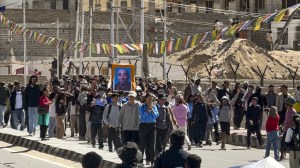Clueless amidst swirling water
Mumbai, the financial capital of India, has suffered gravely due to the unprecedented rainfall on July 26 and 27. Rail, road and air transpo...

Mumbai, the financial capital of India, has suffered gravely due to the unprecedented rainfall on July 26 and 27. Rail, road and air transport as well as telephones were thrown out of order. I was caught in the disaster myself and had to sleep in my car for two days. It took nine hours and a few minutes for me to travel from Sahar Airport to Bandra, a distance of about 9 km.
Some have accused the state government of ineptness in handling the disaster. The administration has countered such criticism by arguing that the gravity of the situation went beyond what normal scientific forecasts and preparations could have met. The total rainfall in one day in Mumbai (945 mm) in 2005 was more than the highest one-day rainfall in Cherapunji (833 mm) in 1910 — which set a global record. But this argument does not fit in the frame of modern scientific research.
To say that the rainfall was unprecedented is a correct statistical statement. However, there have been remarkable developments in the meteorological sciences in the last two decades. It is possible, to some extent, to predict the trend of rainfall. Suppose, at a location — say Mumbai — abnormal rain is recorded for a few hours. Then, if the hourly rainfall is plotted, it is possible to observe the graphical trend. Clubbing this trend with available satellite photos and radar observation, it is possible to predict some characteristics of the rain in the next few hours.
Even the common person can observe the nature of the rainfall. In Mumbai, the rain began some time around 10:00 hours on July 26. The intensity of the rainfall was moderate and raindrops were small in size — until about 13:00 hours. There was then a sudden rise in the intensity of rainfall. This continued beyond 19:00 hours. The enormity of the catastrophe could have been anticipated through continuous monitoring.
On the afternoon of July 27, while I was stranded on the Western Express Highway near Santa Cruz Airport, I saw a helicopter undertake a reconnaissance survey of the situation — it was Vilasrao Deshmukh, the chief minister of the state. This was confirmed by the news on the car radio. The prime minister has also undertaken an aerial survey subsequently. But the use of helicopters must not be limited to VIP visitations. If, for instance, a traffic police officer flies in a helicopter, he could assess the situation and then sent the video pictures to the concerned police stations with suitable instructions. This could help in the speedy clearance of traffic jams. Helicopters could also be used for shifting patients for urgent medical treatment or posting doctors at the site. Widening the use of helicopters may be useful in disaster mitigation.
I could see very few police personnel around. When I asked one policeman about the situation at the next crossing, he had no answer. Mobile phones with cameras could have helped the policemen to deal with the situation in a more informed manner.
The press and electronic media were full of photographs and descriptions of the destruction in Mumbai. But saying that there is heavy flooding in Dadar, Bandra, Goregaon, Andheri, and so on, carries little meaning from the scientific and disaster mitigation point of view. The same news could have been re-drafted in more useful ways. For instance the report could say, “the area in the vicinity of Vile Parle bounded by roads (names of the roads specified) is flooded with about 120 cm of water”. Or the media could advise people not to take Road A, which is flooded, but Road B, and so on.
Finally, I would like to end on a note of caution. Recently, Gujarat suffered an earthquake. The Andamans and the eastern coast, especially Tamil Nadu, have also suffered an earthquake and the consequent tsunami. Both catastrophes were promptly branded as “unprecedented” although there have been similar events of this kind in the past. For Gujarat and Maharashtra, there is a strong possibility of the next hydraulic disaster taking the form of a tsunami. It may be noted that the last disastrous tsunami that hit the westerned coast occurred in 1945. Kandla was hit by tsunami waves, 12 meters in height. The gestation period of the tsunami is already over and it is approaching the value of the return period. So how prepared are we for it?
The writer is a senior seismologist





- 01
- 02
- 03
- 04
- 05


























